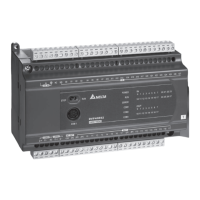2. Programming Concepts
2.6 PLC Bits, Nibbles, Bytes, Words, etc
For different control purposes, there are five types of values inside DVP-PLC for executing the
operations.
Bit is the basic unit of a binary number system. Range is 0 or 1
Nibble
Consists of 4 consecutive bits, e.g. b3~b0. Range 0 ~ 9 in Decimal or 0~F in
Hex
Consists of 2 consecutive nibbles, e.g. b7~b0. Range 00 ~ FF in Hex
Consists of 2 consecutive bytes, e.g. b15~b0. Range 0000 ~ FFFF in Hex
Double Word
Consists of 2 consecutive words, e.g. b31~b1. Range 00000000 - FFFFFFFF
in Hex
Bit, nibble, byte, word, and double word in a binary system:
NB0NB1NB2NB3NB4NB5NB6NB7
BY3 BY2 BY1 BY0
W1
DW
W0
Double Word
Word
Byte
Nibble
Bit
2.7 Binary, Octal, Decimal, BCD, Hex
For fulllfilling different kinds of internal manipulation, DVP-PLC appies 5 foramts of number
systems. Each number system has its specific purpose and function described as below.
1. Binary Number, (BIN)
PLC internally calculates, operates, and stores the value in Binary format.
2. Octal Number, (OCT)
The external I/O points of DVP-PLC are numbered in octal format.
e.g.
External inputs: X0~X7, X10~X17, …, X377. (No. of device)
External outputs: Y0~Y7, Y10~Y17, …, Y377. (No. of device)
3. Decimal Number, (DEC)
DVP-PLC appies decimal operation in situations below:
Set value for timers and counters, e.g. TMR C0 K50. (K value)
No. of S, M, T, C, D, E, F, P, I devices, e.g. M10, T30. (No. of device)
For use of operand in API instructions, e.g. MOV K123 D0. (K value)
4. BCD (Binary Coded Decimal)
BCD format takes 1 digit or 4 bits to indicate a Decimal value, so that data of consecutive 16
bits indicates a 4-digit decimal value. Used mainly for reading values from DIP switches or
sending data to 7-segement displays
5. Hexadecimal Number, HEX
DVP-PLC appies Hexadecimal operation in situations below:
For use of operand in API instructions, e.g. MOV H1A2B D0。(H value)
Constant (K): A decimal number in a PLC is generally preceded by K. For example, K100
represents the decimal number 100.

